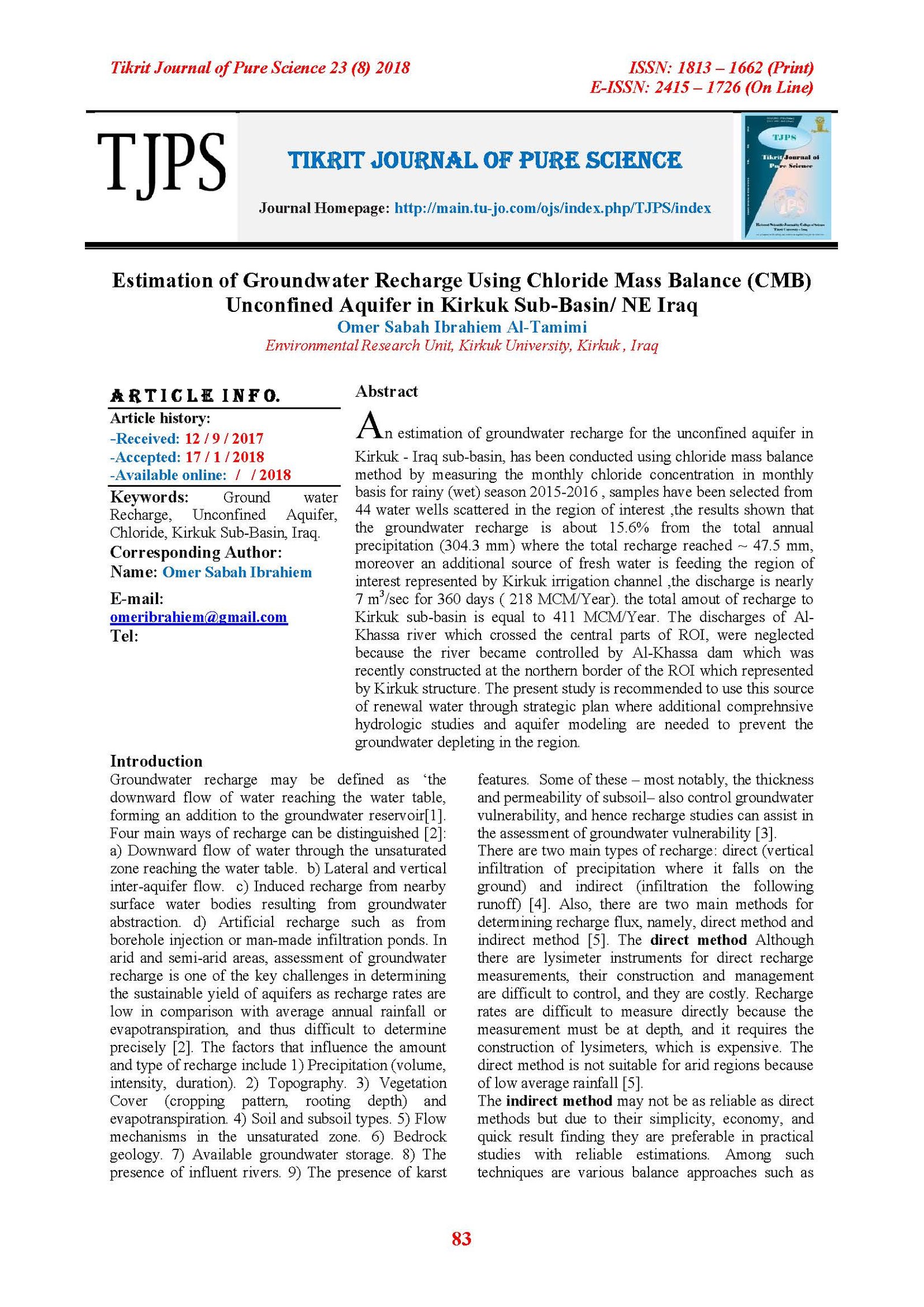Estimation of Groundwater Recharge Using Chloride Mass Balance (CMB) Unconfined Aquifer in Kirkuk Sub-Basin/ NE Iraq
Main Article Content
Abstract
An estimation of groundwater recharge for the unconfined aquifer in Kirkuk - Iraq sub-basin, has been conducted using chloride mass balance method by measuring the monthly chloride concentration in monthly basis for rainy (wet) season 2015-2016 , samples have been selected from 44 water wells scattered in the region of interest ,the results shown that the groundwater recharge is about 15.6% from the total annual precipitation (304.3 mm) where the total recharge reached ~ 47.5 mm, moreover an additional source of fresh water is feeding the region of interest represented by Kirkuk irrigation channel ,the discharge is nearly 7 m3/sec for 360 days ( 218 MCM/Year). the total amout of recharge to Kirkuk sub-basin is equal to 411 MCM/Year. The discharges of Al-Khassa river which crossed the central parts of ROI, were neglected because the river became controlled by Al-Khassa dam which was recently constructed at the northern border of the ROI which represented by Kirkuk structure. The present study is recommended to use this source of renewal water through strategic plan where additional comprehnsive hydrologic studies and aquifer modeling are needed to prevent the groundwater depleting in the region.
Article Details

This work is licensed under a Creative Commons Attribution 4.0 International License.
Tikrit Journal of Pure Science is licensed under the Creative Commons Attribution 4.0 International License, which allows users to copy, create extracts, abstracts, and new works from the article, alter and revise the article, and make commercial use of the article (including reuse and/or resale of the article by commercial entities), provided the user gives appropriate credit (with a link to the formal publication through the relevant DOI), provides a link to the license, indicates if changes were made, and the licensor is not represented as endorsing the use made of the work. The authors hold the copyright for their published work on the Tikrit J. Pure Sci. website, while Tikrit J. Pure Sci. is responsible for appreciate citation of their work, which is released under CC-BY-4.0, enabling the unrestricted use, distribution, and reproduction of an article in any medium, provided that the original work is properly cited.
References
[1] Lerner, D.N.; Issar, A.S. and Simmers, I. (1990). Groundwater recharge: a guide to understanding and estimating natural recharge. International Contributions to Hydrogeology, 8, Tylor and France Heise, Germany: 345 pp.
[2] Xu, Y. and Beekman, H.E. (2003). Groundwater Recharge Estimation in South Africa, Published by UNESCO Paris, printed Cape Town, 207 pp.
[3] Lee, M. (1999). Surface hydrology and land use as secondary indicators of groundwater recharge and vulnerability. Unpublished MSc thesis, Trinity College Dublin.
[3] Misstear, B.D.R. (2000). Groundwater Recharge Assessment: A Key Component of River Basin Management, Published Report in National Hydrology Seminar 2000, Trinty College Dublin, 8 pp.
[4] Șen, Z. (2008). Wadi Hydrology, Taylor & Francis Group, CRC Press, USA, 339 pp.
[5] Wood, W.W. and Sanford, W.E. (1995). Chemical and isotopic methods for quantifying groundwater recharge in a regional semi-arid environment, Groundwater, 33(3):458–468.
[6] Sissakian, V.K. (1992). The Geology of Kirkuk Quadrangle Sheet NI-38- 2, Baghdad, State establishment of Geological Survey & Mining, 44 pp.
[7] Saud, Q.J. (2009). Hydrogeological and Hydrogeochemical Study of Kirkuk Governorate, Northern Iraq. Journal of Iraqi Geology and Mining, 5(1):1-13.
[8] Ahmed, A.M.; Abdulrazak, M.I. and Dawood, K.S. (2005). Hydrogeologic Study for (upper part of Diyala river basin): Ministry of Water Resources, General Directory of water resources Management, groundwater studies center.
[9] Gieske A.S.M. (1992). Dynamics of groundwater recharge, a case study in semi-arid eastern Botswana. Ph.D. Thesis, Vrije Universiteit, Amsterdam: 289 pp.
[10] Hendrickx J.M.H. and Walker G.R. (1997). Recharge from precipitation. In Simmers, I. (Ed), 1997. Recharge of phreatic aquifers in semi-arid areas. International Association of Hydrogeologists (IAH) 19. A. A. Balkema, Rotterdam: 277 pp.
[11] Seiler, K.P. and Gat, J.R. (2007). Groundwater recharge from Run-off, Infiltration, and Percolation. Springer, P. O. Box 17, 3300 AA Dordrecht, the Netherlands: 237 pp.
[12] Hiscock, K.M. (2005). Hydrogeology: principles and practice. Blackwell Science Ltd, UK: 377 pp.
[13] Raghunath, H.M. (2006). Hydrology, Principles. Analysis. Design. 2nd edn, New Age International (P) Ltd: 457 pp.
[12] Kirkuk meteorological Station, available online http://meteoseism.gov.iq .
[13] Ministry of Water Resources, General Directory of water resources Management, groundwater studies center, Iraq.
